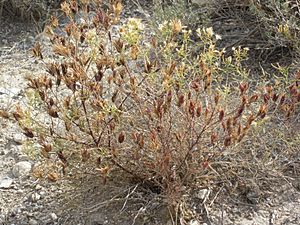Bushy bird's beak facts for kids
Quick facts for kids Bushy bird's beak |
|
|---|---|
 |
|
| Scientific classification | |
| Genus: |
Cordylanthus
|
| Species: |
ramosus
|
Cordylanthus ramosus, also known as the bushy bird's beak, is a special kind of flowering plant. It belongs to the Orobanchaceae family. This plant grows naturally in the western parts of the United States. You can often find it in mountains and high plateaus. It especially likes areas with sagebrush, like the Great Basin.
About the Bushy Bird's Beak
The bushy bird's beak is an annual herb. This means it completes its whole life cycle in just one year. It grows upright and has many branches. The plant usually looks gray-green, but it can also have a reddish tint. When it grows big and strong, it becomes very bushy. It can even look a bit like a sagebrush plant!
What it Looks Like
The leaves of the bushy bird's beak are quite small and narrow. They can be long and thin, or they might be divided into several tiny, thread-like parts.
The flowers grow in a small cluster called an inflorescence. This cluster looks like a spike and has only a few flowers. Around these flowers are special leaves called bracts. These bracts are also narrow and thread-like, just like the regular leaves. They feel a bit woolly and sometimes even bristly.
Each flower is about one to two centimeters long. It has a fuzzy yellow pouch. This pouch is surrounded by darker, tougher reddish parts called sepals.
Traditional Uses
Long ago, the Navajo people used the bushy bird's beak plant in their traditional medicine. They used it in ways that helped people feel better.

